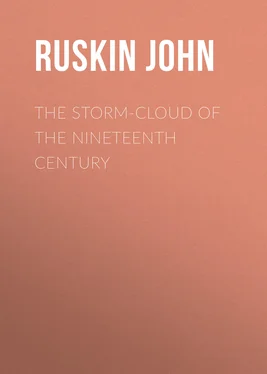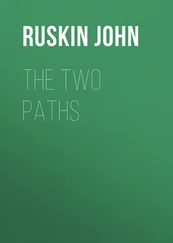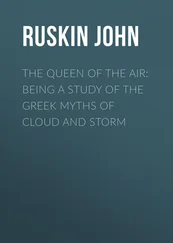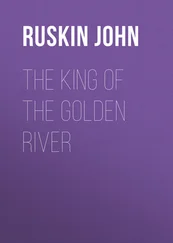John Ruskin - The Storm-Cloud of the Nineteenth Century
Здесь есть возможность читать онлайн «John Ruskin - The Storm-Cloud of the Nineteenth Century» — ознакомительный отрывок электронной книги совершенно бесплатно, а после прочтения отрывка купить полную версию. В некоторых случаях можно слушать аудио, скачать через торрент в формате fb2 и присутствует краткое содержание. Жанр: foreign_prose, literature_19, foreign_antique, на английском языке. Описание произведения, (предисловие) а так же отзывы посетителей доступны на портале библиотеки ЛибКат.
- Название:The Storm-Cloud of the Nineteenth Century
- Автор:
- Жанр:
- Год:неизвестен
- ISBN:нет данных
- Рейтинг книги:3 / 5. Голосов: 1
-
Избранное:Добавить в избранное
- Отзывы:
-
Ваша оценка:
- 60
- 1
- 2
- 3
- 4
- 5
The Storm-Cloud of the Nineteenth Century: краткое содержание, описание и аннотация
Предлагаем к чтению аннотацию, описание, краткое содержание или предисловие (зависит от того, что написал сам автор книги «The Storm-Cloud of the Nineteenth Century»). Если вы не нашли необходимую информацию о книге — напишите в комментариях, мы постараемся отыскать её.
The Storm-Cloud of the Nineteenth Century — читать онлайн ознакомительный отрывок
Ниже представлен текст книги, разбитый по страницам. Система сохранения места последней прочитанной страницы, позволяет с удобством читать онлайн бесплатно книгу «The Storm-Cloud of the Nineteenth Century», без необходимости каждый раз заново искать на чём Вы остановились. Поставьте закладку, и сможете в любой момент перейти на страницу, на которой закончили чтение.
Интервал:
Закладка:
You will not, therefore, so please you, expect me to explain anything to you,—I have come solely and simply to put before you a few facts, which you can't see by candlelight, or in railroad tunnels, but which are making themselves now so very distinctly felt as well as seen, that you may perhaps have to roof, if not wall, half London afresh before we are many years older.
I go back to my point—the way in which clouds, as a matter of fact, become visible. I have defined the floating or sky cloud, and defined the falling, or earth cloud. But there's a sort of thing between the two, which needs a third definition: namely, Mist. In the 22d page of his 'Glaciers of the Alps,' Professor Tyndall says that "the marvelous blueness of the sky in the earlier part of the day indicated that the air was charged, almost to saturation, with transparent aqueous vapor." Well, in certain weather that is true. You all know the peculiar clearness which precedes rain,—when the distant hills are looking nigh. I take it on trust from the scientific people that there is then a quantity—almost to saturation—of aqueous vapor in the air, but it is aqueous vapor in a state which makes the air more transparent than it would be without it. What state of aqueous molecule is that, absolutely unreflective 12of light—perfectly transmissive of light, and showing at once the color of blue water and blue air on the distant hills?
I put the question—and pass round to the other side. Such a clearness, though a certain forerunner of rain, is not always its forerunner. Far the contrary. Thick air is a much more frequent forerunner of rain than clear air. In cool weather, you will often get the transparent prophecy: but in hot weather, or in certain not hitherto defined states of atmosphere, the forerunner of rain is mist. In a general way, after you have had two or three days of rain, the air and sky are healthily clear, and the sun bright. If it is hot also, the next day is a little mistier—the next misty and sultry,—and the next and the next, getting thicker and thicker—end in another storm, or period of rain.
I suppose the thick air, as well as the transparent, is in both cases saturated with aqueous vapor;—but also in both, observe, vapor that floats everywhere, as if you mixed mud with the sea; and it takes no shape anywhere: you may have it with calm, or with wind, it makes no difference to it. You have a nasty haze with a bitter east wind, or a nasty haze with not a leaf stirring, and you may have the clear blue vapor with a fresh rainy breeze, or the clear blue vapor as still as the sky above. What difference is there between these aqueous molecules that are clear, and those that are muddy, these that must sink or rise, and those that must stay where they are, these that have form and stature, that are bellied like whales and backed like weasels, and those that have neither backs nor fronts, nor feet nor faces, but are a mist—and no more—over two or three thousand square miles?
I again leave the questions with you, and pass on.
Hitherto I have spoken of all aqueous vapor as if it were either transparent or white—visible by becoming opaque like snow, but not by any accession of color. But even those of us who are least observant of skies, know that, irrespective of all supervening colors from the sun, there are white clouds, brown clouds, gray clouds, and black clouds. Are these indeed—what they appear to be—entirely distinct monastic disciplines of cloud: Black Friars, and White Friars, and Friars of Orders Gray? Or is it only their various nearness to us, their denseness, and the failing of the light upon them, that makes some clouds look black 13and others snowy?
I can only give you qualified and cautious answer. There are, by differences in their own character, Dominican clouds, and there are Franciscan;—there are the Black Hussars of the Bandiera della Morte, and there are the Scots Grays whose horses can run upon the rock. But if you ask me, as I would have you ask me, why argent and why sable, how baptized in white like a bride or a novice, and how hooded with blackness like a Judge of the Vehmgericht Tribunal,—I leave these questions with you, and pass on.
Admitting degrees of darkness, we have next to ask what color, from sunshine can the white cloud receive, and what the black?
You won't expect me to tell you all that, or even the little that is accurately known about that, in a quarter of an hour; yet note these main facts on the matter.
On any pure white, and practically opaque, cloud, or thing like a cloud, as an Alp, or Milan Cathedral, you can have cast by rising or setting sunlight, any tints of amber, orange, or moderately deep rose—you can't have lemon yellows, or any kind of green except in negative hue by opposition; and though by stormlight you may sometimes get the reds cast very deep, beyond a certain limit you cannot go,—the Alps are never vermilion color, nor flamingo color, nor canary color; nor did you ever see a full scarlet cumulus of thundercloud.
On opaque white vapor, then, remember, you can get a glow or a blush of color, never a flame of it.
But when the cloud is transparent as well as pure, and can be filled with light through all the body of it, you then can have by the light reflected 14from its atoms any force conceivable by human mind of the entire group of the golden and ruby colors, from intensely burnished gold color, through a scarlet for whose brightness there are no words, into any depth and any hue of Tyrian crimson and Byzantine purple. These with full blue breathed between them at the zenith, and green blue nearer the horizon, form the scales and chords of color possible to the morning and evening sky in pure and fine weather; the keynote of the opposition being vermilion against green blue, both of equal tone, and at such a height and acme of brilliancy that you cannot see the line where their edges pass into each other.
No colors that can be fixed in earth can ever represent to you the luster of these cloudy ones. But the actual tints may be shown you in a lower key, and to a certain extent their power and relation to each other.
I have painted the diagram here shown you with colors prepared for me lately by Messrs. Newman, which I find brilliant to the height that pigments can be; and the ready kindness of Mr. Wilson Barrett enables me to show you their effect by a white light as pure as that of the day. The diagram is enlarged from my careful sketch of the sunset of 1st October, 1868, at Abbeville, which was a beautiful example of what, in fine weather about to pass into storm, a sunset could then be, in the districts of Kent and Picardy unaffected by smoke. In reality, the ruby and vermilion clouds were, by myriads, more numerous than I have had time to paint: but the general character of their grouping is well enough expressed. All the illumined clouds are high in the air, and nearly motionless; beneath them, electric storm-cloud rises in a threatening cumulus on the right, and drifts in dark flakes across the horizon, casting from its broken masses radiating shadows on the upper clouds. These shadows are traced, in the first place by making the misty blue of the open sky more transparent, and therefore darker; and secondly, by entirely intercepting the sunbeams on the bars of cloud, which, within the shadowed spaces, show dark on the blue instead of light.
But, mind, all that is done by reflected light—and in that light you never get a green ray from the reflecting cloud; there is no such thing in nature as a green lighted cloud relieved from a red sky,—the cloud is always red, and the sky green, and green, observe, by transmitted, not reflected light.
But now note, there is another kind of cloud, pure white, and exquisitely delicate; which acts not by reflecting, nor by refracting, but, as it is now called, dif fracting, the sun's rays. The particles of this cloud are said—with what truth I know not 15—to send the sunbeams round them instead of through them; somehow or other, at any rate, they resolve them into their prismatic elements; and then you have literally a kaleidoscope in the sky, with every color of the prism in absolute purity; but above all in force, now, the ruby red and the green ,—with purple, and violet-blue, in a virtual equality, more definite than that of the rainbow. The red in the rainbow is mostly brick red, the violet, though beautiful, often lost at the edge; but in the prismatic cloud the violet, the green, and the ruby are all more lovely than in any precious stones, and they are varied as in a bird's breast, changing their places, depths, and extent at every instant.
Читать дальшеИнтервал:
Закладка:
Похожие книги на «The Storm-Cloud of the Nineteenth Century»
Представляем Вашему вниманию похожие книги на «The Storm-Cloud of the Nineteenth Century» списком для выбора. Мы отобрали схожую по названию и смыслу литературу в надежде предоставить читателям больше вариантов отыскать новые, интересные, ещё непрочитанные произведения.
Обсуждение, отзывы о книге «The Storm-Cloud of the Nineteenth Century» и просто собственные мнения читателей. Оставьте ваши комментарии, напишите, что Вы думаете о произведении, его смысле или главных героях. Укажите что конкретно понравилось, а что нет, и почему Вы так считаете.












